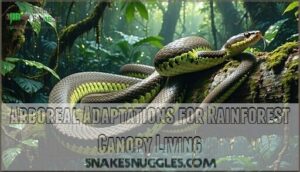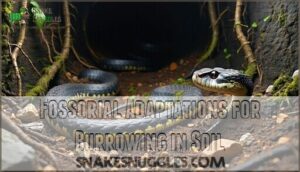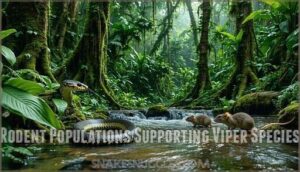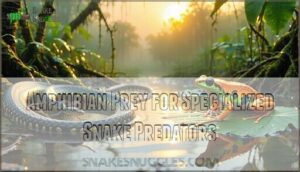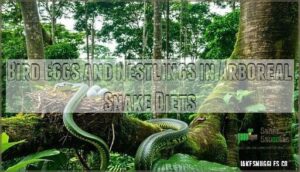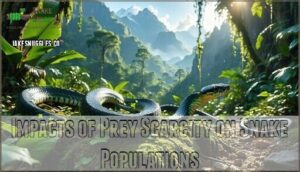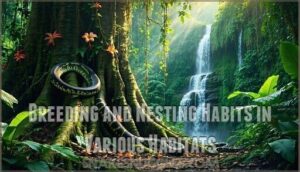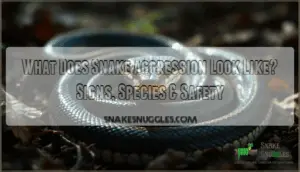This site is supported by our readers. We may earn a commission, at no cost to you, if you purchase through links.
 You’ll discover that snake habitat in South America spans seven remarkable ecosystems, each supporting unique serpent communities.
You’ll discover that snake habitat in South America spans seven remarkable ecosystems, each supporting unique serpent communities.
The Amazon rainforest alone hosts over 120 species, including massive Green Anacondas and agile Garden Tree Boas traversing the canopy.
Cold-tolerant Andean milk snakes thrive at elevations reaching 2,700 meters, while the Pantanal wetlands shelter more than 50 aquatic species like Yellow Anacondas.
The Cerrado savanna supports over 60 heat-resistant terrestrial snakes, and each ecosystem from Atlantic forests to Patagonian steppes offers distinct adaptations you won’t find elsewhere.
These serpents have evolved fascinating survival strategies suited to their specific environments, including unique serpent communities.
Table Of Contents
- Key Takeaways
- Diverse Ecosystems Supporting South American Snake Habitats
- Amazon Rainforest: Home to Numerous Snake Species
- Andean Mountain Ranges: Specialized Snake Adaptations
- Pantanal Wetlands: Aquatic and Semi-aquatic Snakes
- Cerrado Savanna: Habitat for Terrestrial Snake Species
- Atlantic Forest: Unique Snake Biodiversity Hotspot
- Patagonian Steppes: Cold-adapted Snake Populations
- Key Snake Families in South American Habitats
- Adaptations of Snakes to South American Environments
- Impact of Habitat Loss on South American Snakes
- Snake Diet and Prey Availability in Habitats
- Breeding and Nesting Habits in Various Habitats
- Human Interactions With Snakes in South America
- Frequently Asked Questions (FAQs)
- Which South American country has the most snakes?
- What are the big snakes in South America?
- Do king cobras live in South America?
- What South American country has the most snakes?
- What is the habitat of the rattlesnake in South America?
- What is the most dangerous snake in South America?
- Can you survive a fer de lance snake bite?
- Where do snakes live in South America?
- Are there rattlesnakes in South America?
- What is the largest snake in the world found in South America?
- Conclusion
Key Takeaways
- You’ll find South America’s seven distinct ecosystems support over 400 snake species, with the Amazon rainforest alone hosting 120+ species including massive Green Anacondas and agile Garden Tree Boas.
- You’ll discover remarkable adaptations across habitats – from cold-tolerant Andean milk snakes thriving at 2,700 meters to aquatic species like Yellow Anacondas in Pantanal wetlands with specialized swimming abilities.
- You’ll encounter serious conservation challenges as deforestation, agricultural expansion, and climate change fragment snake habitats, forcing species into smaller territories and threatening their survival.
- You’ll learn that understanding snake-human interactions is crucial, from managing snakebite risks in agricultural areas to supporting ecotourism and indigenous practices that promote coexistence with these essential predators.
Diverse Ecosystems Supporting South American Snake Habitats
You’ll find South America’s remarkable geography creates seven distinct ecosystems that support an incredible diversity of snake species.
From the Amazon’s dense canopy to Patagonia’s windswept grasslands, each region offers unique conditions that have shaped specialized snake communities over millions of years.
Amazon Rainforest: Home to Numerous Snake Species
The Amazon Basin contains over 120 snake species, making it South America’s richest snake habitat.
Amazon Basin: Nature’s ultimate snake sanctuary hosts 120+ species in perfect harmony
You’ll find incredible rainforest biodiversity here, from massive Green Anacondas lurking in oxbow lakes to colorful Garden Tree Boas dwelling in the canopy.
These Amazon rainforest snakes showcase remarkable snake adaptations for arboreal living, including prehensile tails and heat-sensing abilities that help them thrive in this complex ecosystem.
Andean Mountain Ranges: Specialized Snake Adaptations
Navigate treacherous Andean peaks and you’ll discover South American snakes with remarkable altitude adaptations.
These cold tolerance champions, like Andean milk snakes, survive at elevations reaching 2,700 meters through specialized thermoregulation. Prey scarcity shapes their hunting strategies, while camouflage strategies help them blend into rocky terrain.
Their limited distribution creates unique evolutionary pressures in these high-altitude living environments.
The Andean milk snake, a colorful alpine subspecies, is known for its distinctive red, black, and yellow stripes.
| Adaptation Type | Species Example | Elevation Range |
|---|---|---|
| Cold Tolerance | Atractus crassicaudatus | 2,000-3,300m |
| Camouflage Strategies | Bothrocophias andianus | 1,500-2,800m |
| Limited Distribution | Synophis zaheri | 2,200-2,700m |
Pantanal Wetlands: Aquatic and Semi-aquatic Snakes
The Pantanal wetlands serve as South America’s aquatic snake sanctuary, supporting over 50 species.
You’ll discover Yellow Anaconda thriving in marsh habitats, using aquatic hunting techniques to ambush prey along riverbanks.
These semi-aquatic snakes showcase remarkable snake diversity, with specialized adaptations for wetland life.
Wetland conservation efforts protect these unique snake habitat types, ensuring Pantanal wetlands remain thriving refuges for South American snakes and their intricate ecosystem relationships.
Cerrado Savanna: Habitat for Terrestrial Snake Species
Brazil’s Cerrado savanna supports over 60 terrestrial snake species through unique adaptations.
These South American snakes have evolved specialized traits for survival in this fire-prone ecosystem.
Terrestrial Adaptations include:
- Heat-resistant scales protecting against ground temperatures
- Advanced burrowing skills for escaping wildfires and extreme heat
- Grassland camouflage patterns mimicking dried vegetation and soil
- Specialized venom targeting savanna rodents and small mammals.
Cerrado Snake Diets consist mainly of ground-dwelling prey like rodents and lizards.
However, Human Impact through agriculture and cattle ranching creates Conservation Challenges for these Unique Species, fragmenting their natural habitat.
Atlantic Forest: Unique Snake Biodiversity Hotspot
Exploring this Atlantic Forest reveals South America’s most remarkable snake biodiversity hotspots.
You’ll discover 249 tropical snake species, with 78 endemic species found nowhere else.
Forest fragmentation threatens these South American snakes, as only 5% of original habitat remains.
The forest once covered twice the size of Texas.
Microhabitat diversity creates specialized niches where snakes develop prey specialization.
Conservation challenges intensify as climate change could eliminate 70% of species’ ranges by 2080, making protection efforts critical.
Patagonian Steppes: Cold-adapted Snake Populations
In Patagonia’s harsh steppes, you’ll discover remarkable South American snakes that’ve conquered extreme temperatures through impressive cold adaptations.
The Patagonian Racer exemplifies these hardy populations, showcasing specialized snake adaptations environment demands.
These cold-adapted populations face challenging conservation status due to climate pressures affecting prey abundance across steppe ecology.
- Extended hibernation periods lasting up to 8 months
- Specialized metabolic adjustments reducing energy by 90%
- Unique hunting strategies targeting scarce warm-blooded prey
- Protective coloration perfectly mimicking rocky terrain patterns
Snake distribution in these remote snake habitats demonstrates nature’s incredible resilience against Patagonia’s unforgiving conditions.
Key Snake Families in South American Habitats
You’ll encounter six major snake families across South America’s diverse landscapes, each perfectly adapted to their specific environments.
These families—from the heat-sensing vipers to the massive constrictors—demonstrate remarkable evolutionary strategies that have allowed them to thrive in everything from dense rainforests to arid steppes, showcasing their ability to adapt to various environments with remarkable precision.
Viperidae: Pit Vipers and Rattlesnakes
You’ll encounter Viperidae family members throughout South America’s ecosystems, where their heat-sensing pits make them deadly nocturnal hunters.
These venomous snakes use pit viper venom and sophisticated venom delivery systems to subdue prey.
| Species | Habitat | Venom Type |
|---|---|---|
| Fer-de-lance | Dense forests | Hemotoxic |
| Neotropical Rattlesnake | Grasslands | Neurotoxic |
| Urutu Lancehead | Woodlands | Cytotoxic |
Rattlesnake behavior includes their iconic warning system, while Viperidae evolution has perfected ambush tactics.
South American snakes in this family represent nature’s most efficient predators.
Elapidae: Coral Snakes and Sea Snakes
You’ll find Elapidae species among South America’s most fascinating yet dangerous residents.
Coral snakes showcase brilliant warning colors through coral snake mimicry, with their neurotoxic venom causing rapid paralysis.
These South American snakes prefer specific microhabitats – forest floors and leaf litter provide perfect hunting grounds.
Sea snake venom evolution differs substantially, adapted for marine prey.
Elapidae conservation faces mounting pressure from habitat specificity requirements.
Venom evolution in this family represents millions of years of predator-prey arms races, creating some of nature’s most potent toxins within these specialized snake habitats in South America.
Colubridae: Diverse Family of Non-venomous Snakes
Colubridae represents South America’s most diverse snake family, with species thriving across rainforests, grasslands, and wetlands.
You’ll encounter colubrids displaying remarkable Colubrid Morphology – from slender tree-dwellers to robust ground hunters.
Their Colubrid Behavior varies dramatically, with some active hunters while others ambush prey.
Colubrid Diet ranges from insects to small mammals, showcasing incredible feeding adaptations.
These nonvenomous snakes face Colubrid Conservation challenges as deforestation threatens their South American homes.
Dipsadidae: Rear-fanged Snakes of The Americas
You’ll encounter over 700 Dipsadidae species across South American snakes, making this the world’s richest snake family.
These rear-fanged serpents showcase incredible diversity in snake habitats throughout South America.
- Mild venom delivery – Rear fangs inject toxins effectively for prey immobilization
- Snail eaters specialization – Modified jaw structures extract mollusks from shells
- Habitat specificity – From Andean highlands to marshland environments
- Nocturnal behavior – Most species hunt actively during nighttime hours
Boidae: Boas and Anacondas
Boidae represents South America’s most impressive snake family, featuring legendary constrictors like the boa constrictor and massive anacondas.
These snakes showcase remarkable Boidae Evolution, with Arboreal Boas developing prehensile tails for tree life while Anaconda Size reaches record-breaking proportions in wetland snake habitats.
Boa Constriction techniques vary by species, from the Garden Tree Boa’s 188-cm length to Green Anacondas weighing 70 kg.
Boidae Conservation efforts across South America focus on protecting these magnificent serpents from habitat loss and human encroachment. They thrive in areas with ideal temperature ranges, essential for thermoregulation.
Leptotyphlopidae: Blind Snakes and Thread Snakes
Underground specialists thrive across South America’s diverse landscapes.
You’ll find these Leptotyphlopidae family members in soil from tropical rainforests to arid grasslands.
Their unique morphology features reduced eyes and streamlined bodies—perfect fossorial adaptations for subterranean life.
Blind snake diet consists mainly of ant and termite larvae.
Despite their global distribution, South American snakes face habitat pressure.
These tiny South American snakes play vital ecosystem roles, though their conservation status remains understudied in many snake habitats.
Adaptations of Snakes to South American Environments
You’ll discover that South American snakes have evolved remarkable adaptations to thrive in the continent’s diverse environments, from the dense Amazon canopy to the arid Patagonian steppes.
These specialized features allow different species to exploit unique ecological niches, whether they’re swimming through flooded wetlands or burrowing beneath forest floors, which is a key aspect of their ability to survive and thrive.
Arboreal Adaptations for Rainforest Canopy Living
High above the forest floor, arboreal snakes showcase remarkable vertical habitat mastery through specialized adaptations.
You’ll discover these rainforest athletes possess extraordinary climbing skills that let them navigate complex canopy networks with ease.
- Prehensile tails function like additional limbs, gripping branches securely during hunting
- Arboreal camouflage patterns mimic bark textures and leaf colors perfectly
- Enhanced depth perception helps judge distances between branches accurately
These arboreal adaptations make South American snakes true canopy movement specialists.
Fossorial Adaptations for Burrowing in Soil
Beneath South America’s surface, fossorial snakes showcase remarkable underground expertise.
These burrowing specialists have evolved incredible adaptations for subterranean life:
- Streamlined Bodies – Cylindrical shapes minimize soil resistance
- Skull Reinforcement – Hardened heads withstand underground pressure
- Scale Reduction – Smooth surfaces enable effortless movement
- Substrate Preference – Species select preferred soil types
You’ll find these snake adaptations particularly fascinating in South American snake habitats, where burrowing behavior varies by ecosystem across the continent.
Aquatic Adaptations for River and Wetland Habitats
Across South America’s waterways, aquatic snakes have developed remarkable streamlined bodies and flattened tails for efficient swimming.
Their water-resistant scales repel moisture while specialized positioning of eyes and nostrils allows surface breathing.
These adaptations enable successful aquatic hunting in the Amazon River and Pantanal wetlands, where species pursue fish and amphibians.
Riverine breeding occurs in shallow areas, demonstrating complete snake adaptation to aquatic environments throughout snake habitats in South America.
Thermoregulatory Adaptations for Diverse Climates
Mastery of temperature control helps South American snakes thrive across diverse climates.
You’ll find these reptiles using behavioral thermoregulation – basking on warm rocks or seeking cool shade.
Metabolic adjustments let them conserve energy during cold periods.
Arboreal shading protects canopy dwellers, while fossorial insulation benefits burrowing species.
Aquatic cooling aids wetland snakes.
These thermoregulatory adaptations guarantee survival from Amazon heat to Patagonian cold.
Camouflage Patterns for Different Ecosystems
South American snakes display remarkable camouflage patterns that help them survive in diverse ecosystems.
You’ll find these adaptations perfectly matched to their environments, making detection nearly impossible for both predators and prey.
Snake camouflage varies dramatically across South America’s unique snake habitats:
- Forest Camouflage: Mottled browns and greens blend with leaf litter
- Desert Camouflage: Sandy yellows and earth tones match arid landscapes
- Aquatic Camouflage: Dark bands mimic water shadows and vegetation
- Mimicry: Harmless species copy dangerous ones for protection
These camouflage patterns represent millions of years of evolution, with Regional Variations reflecting local environmental pressures across different snake habitats in South America.
Venom Evolution in Response to Prey Availability
Beyond camouflage lies nature’s most sophisticated weapon system.
Snake venom composition has evolved into specialized chemical arsenals targeting specific prey types.
This evolutionary arms race produces remarkable prey specificity – each venomous snake’s toxin cocktail matches its preferred diet perfectly.
| Prey Type | Venom Adaptation |
|---|---|
| Mammals | Hemorrhagic toxins |
| Reptiles | Neurotoxic compounds |
| Amphibians | Myotoxic enzymes |
| Birds | Cardiotoxic proteins |
Diet shifts throughout a snake’s life trigger corresponding changes in venom potency.
South American venomous snakes demonstrate how snake evolution responds directly to prey availability across diverse snake habitats.
Impact of Habitat Loss on South American Snakes
You’re witnessing one of the most pressing environmental crises affecting South American wildlife today.
Human activities continue to destroy and fragment the diverse ecosystems that hundreds of snake species call home, forcing these reptiles into smaller territories where they struggle to find food, mates, and suitable shelter, which is a critical issue for their survival in these fragmented areas with limited suitable shelter.
Deforestation Effects on Snake Populations
Deforestation dramatically threatens snake populations across South America’s forests.
When loggers clear vast areas, they create habitat fragmentation that isolates snake communities and disrupts their natural behaviors.
Here’s how deforestation impacts these reptiles:
- Prey depletion reduces food sources as small mammals flee cleared areas
- Species migration forces snakes into unsuitable territories where they can’t survive
- Increased mortality occurs when snakes cross dangerous open spaces between forest patches
- Genetic diversity decreases as isolated populations can’t interbreed
- Breeding sites disappear along with fallen logs and dense vegetation
This habitat destruction pushes many species toward extinction, making snake conservation efforts critical for South America’s biodiversity.
Agricultural Expansion and Snake Habitat Fragmentation
Agricultural expansion relentlessly fragments snake habitat across South America, creating isolated patches where populations can’t survive long-term.
Crop encroachment eliminates natural corridors, while pesticide exposure and prey depletion compound these threats.
Snake relocation efforts help, but habitat corridors remain essential for connecting fragmented areas and preventing local extinctions.
| Before Agricultural Expansion | After Agricultural Expansion |
|---|---|
| Continuous forest habitat | Fragmented patches |
| Stable snake populations | Declining populations |
| Natural prey abundance | Prey depletion zones |
| Safe migration routes | Dangerous crossings |
Urbanization and Snake-human Conflict
As cities expand across South America, you’ll find snakes adapting to urban environments in unexpected ways.
These encounters create complex challenges requiring careful management:
- Snake relocations increase as displaced species seek new territories in residential areas
- Venomous encounters with fer-de-lance and coral snakes pose serious public health risks
- Pet escapes from exotic snake collections add non-native species to local ecosystems
- Public perception often leads to unnecessary killing of beneficial, non-venomous species
Mitigation strategies focus on education and professional removal services rather than elimination.
Climate Change Altering Snake Habitats
Rising temperatures force you to witness dramatic Habitat Shifts as snakes migrate to cooler elevations and latitudes.
Climate change disrupts traditional snake habitat patterns across South America, creating Temperature Extremes that challenge snake adaptation.
Species Migration follows changing Prey Availability, while altered rainfall affects snake habitats in South America.
These shifts demand innovative Conservation Strategies to protect vulnerable populations adapting to our changing planet.
Conservation Efforts for Endangered Snake Species
You’ll find dedicated snake conservation efforts across South America targeting endangered species through proven strategies.
Scientists implement captive breeding programs to boost genetic diversity while maintaining viable populations. Anti-poaching measures protect vulnerable species from illegal collection, particularly venomous snakes valued for their venom. To combat this, specialized tools are used, including snake anti-poaching equipment. Community engagement proves essential, as local people become conservation partners rather than threats.
Key snake conservation initiatives include:
- Habitat preservation projects protecting critical breeding and feeding areas
- Research programs monitoring snake species populations and snake threats South America
- Education campaigns reducing human-snake conflicts in rural communities
These thorough snake conservation efforts address immediate dangers while building long-term protection for snake habitats throughout the continent.
Habitat Restoration Projects Benefiting Snake Populations
While conservation efforts focus on protecting endangered species, habitat restoration projects are actively rebuilding the landscapes these snakes call home.
You’ll find these projects making real differences across South America’s diverse ecosystems.
Corridor Creation connects fragmented habitats, allowing snakes to move freely between areas.
In Brazil’s Atlantic Forest, these wildlife highways help coral snakes access broader territories for hunting and breeding.
Reforestation Efforts in the Amazon restore canopy homes for arboreal species like the Garden Tree Boa.
These projects plant native trees that support the entire food web snakes depend on.
Invasive Removal programs clear non-native plants that disrupt natural ecosystems.
When you remove invasive grasses from Cerrado savannas, native vegetation returns, supporting prey species that feed local rattlesnakes.
Prey Augmentation projects restore populations of frogs, rodents, and birds that snakes need to survive.
Community Involvement guarantees local people understand how healthy snake habitats benefit everyone.
These snake habitat restoration initiatives across South America show measurable success, with some projects achieving 80% effectiveness in restoring snake habitats and supporting snake conservation.
Snake Diet and Prey Availability in Habitats
You’ll find that South American snakes have evolved remarkable dietary strategies to exploit the abundant prey resources across diverse ecosystems.
From fer-de-lances targeting rodents in coffee plantations to aquatic species like the Mountain Keelback ambushing fish in Amazon waters, each snake’s hunting success depends entirely on the availability and distribution of their preferred prey species, which is a key factor in their hunting success and ability to thrive in various environments with abundant prey.
Rodent Populations Supporting Viper Species
Rodent abundance creates a thriving ecosystem for South America’s pit vipers. These agile predators have perfected their hunting strategies around mice and rat populations.
Here’s how rodent populations support viper species:
- Dense rodent colonies provide consistent food sources for growing viper populations
- Seasonal breeding cycles align perfectly with peak rodent availability periods
- Underground burrow systems create hunting grounds where vipers ambush unsuspecting prey
- Agricultural areas concentrate both rodent populations and opportunistic viper species
This ecological balance maintains habitat health through natural pest control, with venom potency evolving specifically for efficient rodent capture.
Effective residential rodent solutions can impact local viper prey.
Amphibian Prey for Specialized Snake Predators
Why do certain South American snakes develop such specialized hunting techniques for amphibians? These predators have evolved remarkable adaptations to overcome their prey’s defenses.
Rear-fanged snakes deliver venom specialization perfectly suited for amphibian toxins, while predator adaptations help them navigate wetland habitats where prey abundance peaks during breeding seasons.
You’ll discover these snake predators South America has perfected fascinating strategies, from mimicking poison dart frogs to timing hunts with rainfall patterns that bring frogs out of hiding. Some enthusiasts even collect items related to rear-fanged snake venom.
Amphibian defenses these specialized hunters must overcome:
- Toxic skin secretions that can kill most predators instantly
- Explosive jumping abilities that launch frogs six feet in seconds
- Camouflage so perfect they vanish against bark and leaves
- Warning calls that alert entire frog communities to danger
- Seasonal disappearance during dry periods when they burrow deep
Fish as Food Source for Aquatic Snakes
Beneath the surface of South America’s rivers and wetlands, you’ll discover aquatic snakes that have mastered underwater predation tactics.
These specialized hunters target diverse fish species using streamlined bodies and powerful jaws. The Mountain Keelback ambushes fish in Amazon basin waters, while anacondas rely on constriction techniques.
Their success depends on healthy fish populations and habitat fish abundance. Digestive adaptations allow efficient processing of scaly prey, making fish essential components of the South American snake food web ecosystem.
These snakes, being carnivores, often rely on stealth and ambush to capture their aquatic prey, utilizing stealth to achieve their hunting goals.
Invertebrate Prey for Smaller Snake Species
Many smaller snakes in South America thrive on invertebrate prey, creating specialized snake diet South America patterns.
These snakes target specific prey to reduce competition:
- Ants and Termites – Primary food for thread snakes and blind snakes
- Beetle Larvae – Rich protein source found in rotting logs
- Spider Consumption – Worm Predation supplements diets of rear-fanged species
This Insect Diversity supports numerous snake prey relationships across South America’s ecosystems.
Bird Eggs and Nestlings in Arboreal Snake Diets
Among towering trees in South America’s canopy, arboreal snakes execute sophisticated raids on bird nests. These scaly acrobats demonstrate remarkable egg predation skills, substantially impacting bird populations across diverse ecosystems.
Nestling vulnerability peaks during breeding seasons when these specialized predators strike:
- Garden Tree Boas swallow whole eggs using flexible jaws
- Giant Parrot Snakes target defenseless chicks in exposed nests
- Western Rainbow Boas time attacks when parent birds forage
This dietary impact shapes forest dynamics, with snake prey availability directly influencing reproductive success in South America’s avian communities.
Impacts of Prey Scarcity on Snake Populations
Prey scarcity triggers population bottlenecks in South American snake communities.
When food becomes scarce, you’ll see reproduction decline by up to 85% as females delay breeding.
Dietary shifts become survival necessities, forcing snakes beyond their typical geographic range.
Drought periods increase mortality rates by 24%, while snake population density drops dramatically.
Snake behavior changes include risky foraging that exposes them to more snake predators.
| Impact Category | Consequence |
|---|---|
| Reproductive Success | 85% decline in breeding females |
| Population Survival | 24% mortality increase during droughts |
| Behavioral Changes | Increased predator exposure risk |
Breeding and Nesting Habits in Various Habitats
You’ll find that South American snakes have developed remarkable breeding strategies perfectly suited to their diverse habitats, from live births in cold mountain regions to elaborate nest-building in tropical forests.
Understanding these reproductive adaptations reveals how each species has evolved to maximize their offspring’s survival chances in everything from rushing rivers to dense jungle canopies, which is a key factor in their ability to thrive in such diverse habitats.
Viviparous Reproduction in High-altitude Snakes
Snake reproduction takes a fascinating turn when you climb South America’s towering Andes mountains. Altitude constraints force these remarkable reptiles to adapt their reproductive strategies for survival.
At high elevations, many snake species practice viviparity—giving birth to live young instead of laying eggs. This maternal investment offers vital evolutionary advantages.
The extended gestation period allows mothers to regulate embryo temperatures through behavioral thermoregulation, something impossible with buried eggs in freezing mountain soils. Offspring survival rates increase dramatically when babies emerge fully developed and ready to hunt. The process is influenced by hormonal control of mating.
High-altitude living demands these specialized adaptations across Andean snake populations:
- Temperature control: Mother’s body maintains ideal embryo development temperatures
- Extended care: Longer gestation periods guarantee stronger, more capable newborns
- Smaller broods: Energy investment focuses on fewer, healthier offspring
- Timing advantage: Babies born during favorable weather windows for survival
- Immediate mobility: Live young can immediately seek shelter and food sources
Oviparous Species’ Nesting Sites in Forests
Throughout South America’s dense rainforests, oviparous snakes carefully select nesting sites that balance protection with ideal conditions.
These species face unique Ground Nesting Challenges, from flooding to predators, making Nesting Material Choices critical for survival.
| Nesting Strategy | Key Features |
|---|---|
| Canopy Nesting | Elevated protection, stable temperatures |
| Ground Nesting | Leaf litter cover, moisture control |
| Hollow Selection | Natural cavities, predator avoidance |
| Material Layering | Organic debris, thermal regulation |
Forest Nest Microclimates determine success rates, while Egg Predation Risks drive location choices in these diverse snake habitats.
Aquatic Snake Breeding in Riverine Habitats
Exploring snake breeding in South America’s riverine habitats reveals fascinating adaptations.
Water-loving serpents like anacondas use riverbank nesting sites during specific breeding seasons.
Water quality directly impacts juvenile survival rates in these aquatic environments.
Snake reproduction includes elaborate mating rituals:
- Males compete through ritualized combat displays near water sources
- Females select prime nesting locations along protected riverbanks
- Temperature regulation occurs through strategic positioning in shallow waters
Seasonal Breeding Patterns Across Different Ecosystems
Different snake species across South America have developed distinct breeding windows that match their environment’s unique rhythms.
You’ll find these patterns vary dramatically based on location and available resources.
Rainforest Breeding occurs during peak fruit seasons when prey populations explode.
Savanna Reproduction aligns with wet seasons, while Wetland Nesting happens as waters recede.
Mountain Mating is limited to brief warm periods, and Steppe Ovulation follows spring emergence patterns.
Key seasonal adaptations include:
- Temperature triggers – Most species require specific thermal thresholds for successful reproduction
- Prey abundance cycles – Snake breeding season coincides with rodent and amphibian population peaks
- Rainfall patterns – Wet seasons provide ideal humidity for egg development
- Photoperiod changes – Day length variations signal reproductive hormones
- Habitat accessibility – Seasonal flooding affects nesting site availability
Climate shifts are disrupting these ancient timing mechanisms throughout South America’s snake habitat regions.
Parental Care in Certain South American Snake Species
You’ll find that some South American snakes display remarkable parental dedication. Female bushmasters guard their eggs for three months, while others provide postnatal care after live birth.
These snake parenting behaviors challenge traditional views of reptilian behavior.
| Species | Care Type | Duration |
|---|---|---|
| Bushmaster | Egg Guarding | 3 months |
| Rainbow Boa | Nest Site Defense | 2 months |
| Pitvipers | Postnatal Care | Days to weeks |
This offspring defense guarantees higher survival rates in predator-rich South American environments.
Impact of Habitat Quality on Reproductive Success
You’ll discover that habitat quality directly determines your snake species’ reproductive success across South America.
Food availability, secure nesting sites, and climate stability create the perfect breeding conditions, while habitat fragmentation disrupts genetic diversity and predator-prey balance.
Key factors affecting snake reproduction:
- Food abundance – Well-fed females produce larger clutches with higher survival rates
- Safe nesting sites – Protected locations reduce egg predation and increase hatching success
- Stable microclimates – Consistent temperatures guarantee proper embryonic development in snake ecology
Human Interactions With Snakes in South America
You’ll encounter South American snakes in various settings, from dense Amazon rainforests where fer-de-lance bites cause most snakebite incidents to urban areas where false coral snakes adapt to city life.
These interactions range from dangerous encounters requiring immediate medical attention to beneficial relationships where indigenous cultures use snake venom for traditional medicine and modern researchers develop life-saving treatments.
Snakebite Incidence in Different Habitats
Across South America’s varied landscapes, snakebite incidence fluctuates dramatically based on specific habitat risk factors and human activities.
The Amazon rainforest records rates up to 10 times higher than national averages, with agricultural workers facing the greatest occupational snakebite risk during rainy seasons.
Snakes often bite humans as a defensive mechanism.
- Amazon Basin: Highest incidence rates with limited medical resource access in remote areas
- Cerrado/Pantanal: Over 60% of state-level cases occur in ranching regions during flood seasons
- Andean Highlands: Lowest rates below 1 per 100,000 inhabitants due to altitude limitations
- Atlantic Forest: Moderate localized clusters with better preventative measures effectiveness than remote regions
Traditional Uses of Snakes in Indigenous Cultures
Beyond the dangers of snakebites, indigenous cultures across South America have embraced snakes for centuries.
You’ll discover medicinal applications using snake oils and venoms to treat ailments.
These serpents hold deep ritualistic significance in ceremonies, while snake symbolism appears in art and traditional crafts.
Some communities include snakes as food sources, and rich snake folklore shapes cultural identity throughout indigenous cultures.
Snake Venom Research and Medical Applications
South American venomous snakes yield powerful compounds for modern medicine.
Researchers extract snake toxins from species like Fer-de-lance and Brazilian Lancehead for toxin characterization and peptide synthesis.
Snake venom components show promise in drug discovery, targeting blood clots and cancer cells.
Clinical trials test these venom antidotes and therapeutic applications.
Snake research laboratories across the continent study snake antivenom production, transforming deadly bites into healing treatments for global healthcare advancement.
Ecotourism Focused on Snake Observation
While venom research advances medical science, snake-focused ecotourism offers you firsthand encounters with South America’s remarkable serpents.
Guided tours provide safe, educational experiences that support Habitat Preservation and Local Communities through Economic Benefits.
- Night walks using proper Viewing Techniques to spot nocturnal species
- Photography expeditions in prime snake habitats with expert guides
- Educational programs covering snake behavior and Ethical Considerations
- Conservation workshops connecting snake observation with ecosystem protection
Challenges in Snake Conservation Education
While ecotourism brings snake awareness, snake education faces significant obstacles in South America.
Public Perception remains negative due to Cultural Beliefs linking snakes to danger.
Misinformation Spread through social media amplifies fears about snake threats.
Funding Limitations restrict Educational Resources development for snake awareness programs.
Snake conservation status suffers when communities can’t access accurate information about these essential species.
Snake myths
Coexistence Strategies in Snake-inhabited Areas
Creating safe coexistence in South America’s snake habitats requires practical strategies that protect both humans and wildlife.
Community Education programs teach residents about local species and Safe Practices for avoiding dangerous encounters. Snake Relocation services help move snakes from populated areas without harm. Habitat Preservation efforts maintain natural boundaries between human settlements and snake territories.
Effective coexistence strategies include:
- Keeping Venom Antidotes readily available in remote communities
- Training locals in snake identification and first aid
- Establishing clear pathways that minimize human-snake encounters
- Supporting research that improves our understanding of snake behavior.
These approaches reduce snake bites while fostering respect for these remarkable predators. They are part of a broader effort to promote Community Education and Habitat Preservation, which are crucial for maintaining a healthy balance between humans and wildlife, and for ensuring Safe Coexistence in areas where snakes are present.
Frequently Asked Questions (FAQs)
Which South American country has the most snakes?
Boldly boasting Brazil’s biodiversity, you’ll find this country harbors approximately 420 snake species across its vast Amazon rainforest and diverse ecosystems, making it South America’s snake champion.
What are the big snakes in South America?
You’ll find South America’s most impressive serpents in the Green Anaconda, reaching 15+ feet and weighing 70kg, plus Boa Constrictors averaging 13 feet, and Tiger Rat Snakes stretching 8-10 feet long.
Do king cobras live in South America?
No, king cobras don’t live in South America – they’re exclusively found in Asia.
You won’t find these iconic hooded serpents slithering through South American rainforests despite the continent’s impressive snake diversity.
What South American country has the most snakes?
Brazil claims the crown for snake diversity, with over 400 species slithering through its vast rainforests.
You’ll find over 100 of them being snakes in the South American rain forest, 60 percent of which lies within Brazilian borders, highlighting the country’s role in rainforests.
What is the habitat of the rattlesnake in South America?
You’ll find the Neotropical Rattlesnake in South America’s grasslands, savannas, and dry forests.
This venomous species prefers open areas with scattered vegetation, avoiding dense rainforests while thriving in Brazil’s Cerrado region.
What is the most dangerous snake in South America?
Ever wonder which snake you’d least want to encounter on a jungle trek?
You’ll want to avoid the Fer-de-lance – it’s South America’s deadliest serpent, causing most snakebite fatalities with venom that triggers severe internal bleeding.
Can you survive a fer de lance snake bite?
You can survive a fer-de-lance bite with immediate medical treatment.
This highly venomous snake causes internal bleeding and severe tissue damage, but antivenom and prompt hospital care substantially improve survival odds.
Where do snakes live in South America?
You’ll find snakes throughout South America‘s diverse ecosystems. They inhabit Amazon rainforests, Pantanal wetlands, Atlantic forests, grasslands, mountains, rivers, and even urban areas, adapting to each environment’s unique conditions.
Are there rattlesnakes in South America?
You’d think rattlesnakes stick to North America, but South America hosts the Neotropical Rattlesnake. This venomous species causes muscle paralysis and organ failure, requiring immediate medical attention if you’re bitten.
What is the largest snake in the world found in South America?
The Green Anaconda is the world’s largest snake, reaching up to 500 centimeters long and weighing 70 kilograms. You’ll find these massive constrictors throughout South America’s wetlands and rivers.
Conclusion
Before smartphones existed, naturalists relied on field guides to identify these remarkable creatures you’ll encounter across diverse landscapes.
South America’s snake habitat showcases extraordinary biodiversity through seven distinct ecosystems, each supporting specialized serpent communities.
You’ve learned how Amazon rainforests shelter over 120 species, while Andean peaks host cold-adapted milk snakes at 2,700 meters.
The Pantanal’s wetlands nurture aquatic anacondas, and Cerrado savannas support heat-resistant terrestrial species.
Understanding these habitats helps you appreciate conservation needs and coexistence strategies essential for protecting these fascinating reptiles.
- https://www.oneearth.org/ecoregions/patagonian-steppe/
- https://en.wikipedia.org/wiki/Viperidae
- https://reptile.guide/false-water-cobra/
- https://royalsocietypublishing.org/doi/full/10.1098/rspb.2018.1003?url_ver=Z39.88-2003&rfr_id=ori%3Arid%3Acrossref.org&rfr_dat=cr_pub%3Dpubmed
- https://sta.uwi.edu/fst/lifesciences/sites/default/files/lifesciences/documents/ogatt/Spilotes_pullatus%20-%20Tiger%20Rat%20Snake%20or%20Clibo.pdf


